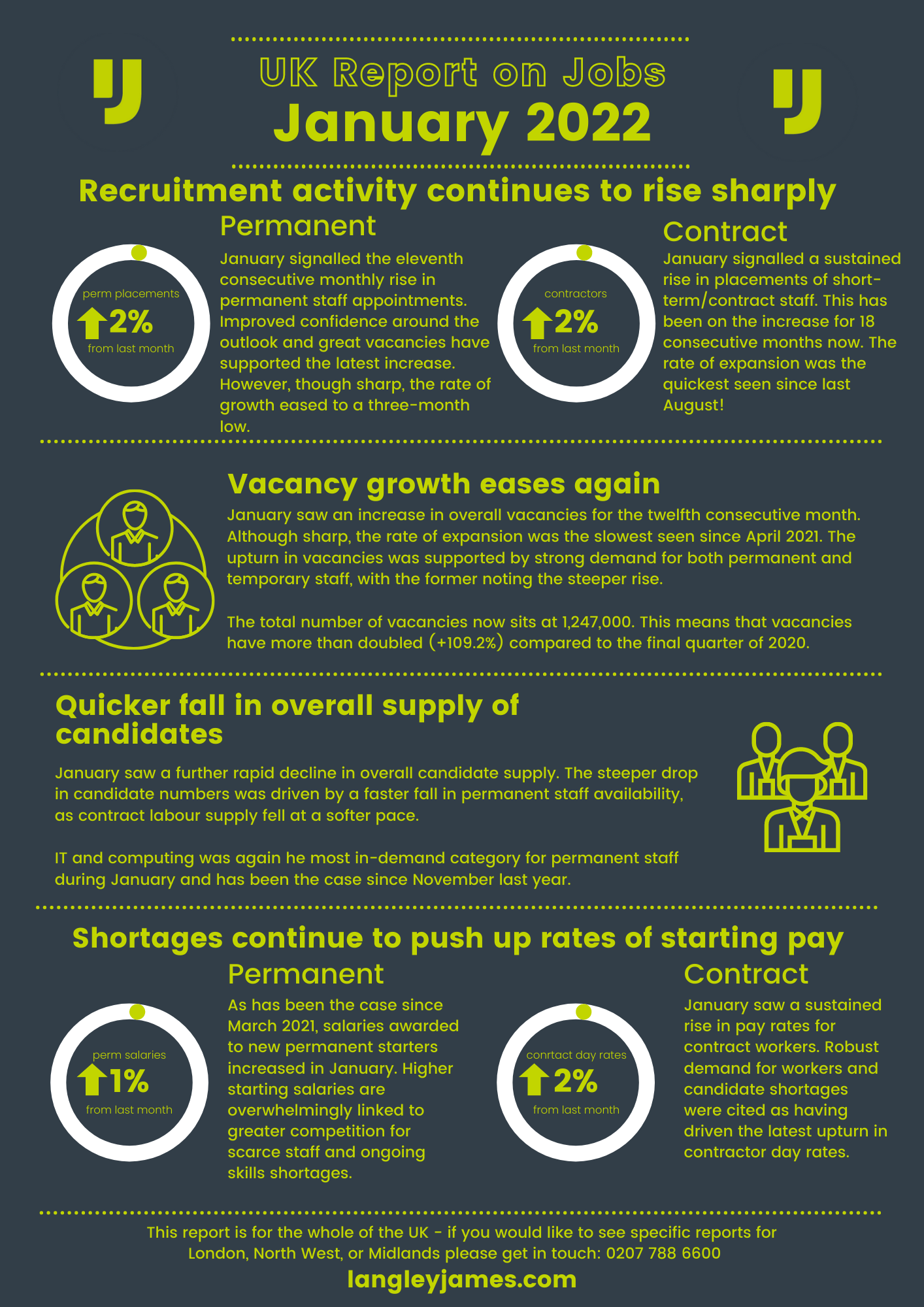
Feb 21, 2022 | Hiring Resources, IT, Tips
IT talent has always been in high demand, but no more so than right now! We are now at the point where many companies are chasing the same scarce talent. Therefore, we are seeing double-digit pay increases in some areas of IT. But where does it end? And what about the companies that are unable to pay inflated salaries? What happens to them?
We’ve researched the current IT jobs market to find ways to enable you to recruit someone worth recruiting, without having to pay 6 figures salaries.
IT Talent Most in Demand
According to data from CIO.com, the 10 most in-demand tech jobs for this year are –
- Database Administrator / Architect
- Information Security Analyst
- Software Developer
- Network & Computer Systems Administrator
- Computer Programmer
- Web Developer
- Information Systems Manager
- Systems Analyst
- Helpdesk / Desktop Support
- Network / Cloud Architects
And we are hearing the same reports from the job boards too. Of the hardest job titles to fill, 8 out of 20 are in the IT sector and are remaining vacant no the job boards for 3 months+. Again, not terribly helpful if you have an urgent IT job to fill.
But this could be a double-edged sword for many companies. Not only are you trying to secure the best candidates (and paying more for them!), but your own teams are also asking for pay rises due to inflation, or even worse, they are offered a considerable increase to move to another company. You then have a decision to make. Is it cheaper to agree a higher salary to keep hold of them? Whilst this does work in some cases, over 80% of people still move on within 6 months of accepting a counter offer. So, think carefully before you react to any resignations.

Shorten Your Time to Hire IT Talent
Is your recruitment process preventing you from securing the best talent? Candidate expectations are changing and to secure the best IT talent, you need to shorten your interview process to just 1 or 2 stages. These stages also ideally need to be remote so that the candidates can fit them into their day. You can always invite the candidate in to receive the job offer at the end of the process. But don’t let a 2- or 3-week interview process stop you from achieving your business goals. Here’s our advice on timescales –
- CV Feedback – 24 hours maximum. Ideally same day.
- 1st interview – within 2 days of receiving CV. Ideally remote
- 2nd interview – if absolutely necessary within 1-2 days of 1st interview
- Offer – within 24 hours of final interview
Whilst sticking to these timescales doesn’t guarantee that you’ll secure your first-choice candidate, it does give you a better chance. However, it also means that you are less likely to be wasting your time on interviews that candidates are quickly going to withdraw from.
Purpose Before Profit
Do you have a company mission? What is it that your business does that helps others? IT talent, especially younger candidates are very selective about who they work for. If an in-demand candidate receives 3 equal job offers, there decision is likely to be based on your purpose. Gone are the days of wanting to work for a ‘growth-at-all-costs’ company. For some companies there is a clear mission. One that can easily be communicated to candidates at interview. However, there are companies that need to be a little more creative when it comes to communicating their mission. Take a look at yours and make sure it’s fit for purpose before interviewing.
How Langley James can help you to secure the best IT talent
Not all recruiters are the same! It’s important to choose carefully who you work with, especially in times of a skills shortage. You don’t want a recruiter who just posts your roles on a jobs board. We’ve shown above that this is no longer the answer! The superstar IT candidates are not to be found in advert response. They are the candidates on databases, in recruiters’ networks, and recommendations. So be sure to ask the right questions of your recruiter next time you are hiring IT talent. We’d be happy to answer any questions you have, show you testimonials and even put you in touch with our clients. Just ask – we are here to help.

Feb 11, 2022 | IT, Management, Tips
Today, discussing leadership style has become an extremely popular area. Many argue that a manager’s leadership style is one of the fundamental elements that determines the extent of both business and employee success. Therefore, it’s important that you understand your leadership approach. You can then decide if it’s working for you, your employees, and the overall business. You want to ensure that you are driving the business to meet its goals and objectives and be the best it can be. Therefore, it might be necessary that you take a step back, evaluate your approach and adapt it accordingly.
Below are five common leadership styles. Have a read and figure out which one best describes you. Hint – there isn’t one best way!
Transactional Leadership Style
This tends to be thought of as the traditional leadership approach. A transformational leader implements strict rules and shows little understanding for people’s circumstances outside of work. For example, people would have to use their holidays to attend doctor’s appointments or attend their child’s sports day. The rewards and punishments your IT team receive are contingent upon their performance. As a result, rules, procedures, and standards are essential in transactional leadership. Your focus is enhancing your own success and development along with that of the organisation. However, in some situations this approach does work well. For example, research has found that transactional leadership tends to be most effective in situations where problems are simple and clearly defined. It also works well in crisis situations.
Transformational
Being a transformational leader means focusing on the needs of others, rather than your own. You treat each employee as an individual. Helping them find a work, life balance that suits them. This can often result in implementing flexible working hours. You’re all about motivating and encouraging your IT team to achieve both their own and the organisation’s goals and objectives. But do so without micromanaging. You strongly believe in trusting your employees to get the job done and the job done well. Give them the opportunity to be creative and look to the future. What’s great about a transformational leader is that they are often extremely passionate, energetic, enthusiastic and love to challenge the status quo. You are a brilliant role model and strive towards setting examples of how things should be done.
Authentic Leadership Style
Authenticity is described as ‘owning one’s personal experiences. For example – thoughts, emotions, needs, wants, preferences and beliefs’. Therefore, an authentic leader must understand their values and act accordingly. Rather than forcing their employees to follow their lead, they show authenticity by inspiring them to do so. Acting with integrity and agreeing on shared values. As a result, authentic leaders can achieve strong employee loyalty and commitment. There are four key components of authentic leadership. Self-awareness, relational transparency, balanced processing, and internalised moral perspective (do the right thing). However, entirely authentic leadership can be hard to achieve as people’s perceptions of what authenticity means can vary on a large scale.

Servant
Servant leaders work to achieve long-term, organisational goals by. They firstly facilitate the growth, development, and general well-being of the individuals in the IT team whilst sharing their power. This approach is great for building strong relationships with your employees. It truly demonstrates that you want to serve their needs. To help them be the best they can be. On the other hand, however, there is a danger that your employees might walk over you. You may find it hard to gain the respect that leaders with different styles can achieve. This is a balancing act so approach with caution.
Laisse – Faire
This is an extremely hands-off approach. Although you provide the tools and resources needed, you offer your IT team very little guidance. You give them complete freedom to make decisions on their own. As a result, people often have a lack of role awareness and poor involvement in the group. This can be demotivating and uninspiring. However, in some situations, this style works well. For example, experienced and highly skilled individuals require very little guidance, and some people appreciate the autonomy. This allows them to feel more satisfied with their work.
Leadership Style Round Up
Globalisation and social media amongst many other things has allowed leaders around the world to witness different culture’s leadership styles. This has prompted them to re-evaluate their own and we are now finding that people are steering away from traditional approaches such as transactional. There is now a huge emphasis on the importance of employee wellbeing. Most would agree that in order to run a successful, profitable business, you must ensure that your entire workforce is happy, fulfilled and motivated. However, it would be extremely difficult to adopt just one approach, therefore, taking different traits from the each of the different styles can help you become a leader that works for you and your business. Being able to do this shows you are diverse and after all, a diverse leader makes for a successful one!
If you enjoyed reading this article, why not follow our LinkedIn page to make sure you don’t miss out on the next!







Recent Comments